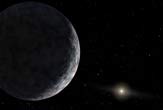Frozen World of Eris Looks a Lot Like Pluto

The frozen surface of the dwarf planet Eris looks a lot like that of its smaller neighbor Pluto, new research has found.
Both frozen worlds are covered predominantly with nitrogen ice, a research team announced Tuesday (Oct. 5). The find could help astronomers get a better handle on the history of the outer reaches of the solar system, scientists said. [Artist's rendition of Eris.]
"By measuring and then comparing and contrasting the properties of Eris and Pluto, we can better understand how planets in the outer solar system formed and then evolved over the last 4.5 billion years," study researcher William Grundy, an astronomer at Lowell Observatory in Flagstaff, Ariz., said in a statement.
The research team announced the discovery at the 42nd meeting of the American Astronomical Society's Division for Planetary Sciences in Pasadena, Calif
Dwarf planets with baggage
Eris, discovered in 2005 by planet-hunting astronomer Michael Brown, has one known moon called Dysnomia.
Eris is larger than Pluto — about 1,600 miles (2,581 kilometers) across, compared with 1,430 miles (2,306 km) — and about 27 percent more massive. Eris' bulk effectively forced astronomers to strip Pluto of its planethood and rebrand it a "dwarf planet" back in 2006.
Sign up for the Live Science daily newsletter now
Get the world’s most fascinating discoveries delivered straight to your inbox.
The ensuing controversy over Pluto's demotion makes Eris' name quite fitting: Eris is the Greek goddess of discord and strife, who stirred up jealousy and envy among the goddesses, leading to the Trojan War.
Eris circles the sun from about 9 billion miles (15 billion km) away, making it about twice as remote as Pluto.
Recreating a dwarf planet's surface in the lab
Grundy and his colleagues used a comparative method to determine what the surface of Eris is made of.
In a laboratory at Northern Arizona University, scientists grew ice samples of methane, nitrogen, argon, methane-nitrogen mixtures and methane-argon mixtures in a vacuum chamber at temperatures as low as minus 390 degrees Fahrenheit (minus 234 Celsius) — mimicking the freezing-cold surfaces of Eris and Pluto.
Light passing through the samples revealed the "chemical fingerprints" of certain molecules and atoms, which were then compared to telescopic observations of sunlight reflected from the surfaces of Eris and Pluto.
"By combining the astronomical data and laboratory data, we found about 90 percent of Eris' icy surface is made up of nitrogen ice and about 10 percent is made up of methane ice, which is not all that different from Pluto," researcher David Cornelison of Missouri State University said in a statement.
Such "ice lab" facilities are rare, researchers said.
"There are only a handful of such labs doing this kind of work in the world," lead researcher Stephen Tegler of Northern Arizona University said in a statement. "By studying surfaces of icy dwarf planets, we hope to get a better understanding of the processes that affect their surfaces."
The research has been submitted for publication to the Astrophysical Journal.










